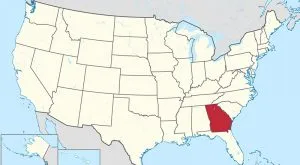Georgia, a state of diverse landscapes ranging from the majestic Appalachian Mountains to the dense coastal plain forests, is a paradise for those passionate about exploring the wilderness. However, this pristine beauty also harbors numerous challenges. To ensure a fulfilling and safe journey through Georgia’s forests, equipping yourself with basic survival skills is crucial. This article will provide essential survival knowledge and skills, helping you confidently conquer the beautiful forests of Georgia, from dealing with unpredictable weather to handling emergency situations that may arise in the wild.
Exploring Georgia’s Forests: Beauty and Challenges
Georgia is not only famous for the vibrant city of Atlanta or its charming coastline but also boasts vast primeval forests, rich in biodiversity and stunning natural landscapes. From the Chattahoochee-Oconee National Forest with its towering peaks to the Ocmulgee National Forest with its ancient historical sites, Georgia offers countless options for those who love trekking, camping, and exploring nature.
However, hiking in Georgia’s forests is not just a fun experience but also a real challenge. The diverse terrain, unpredictable weather, and the presence of wildlife require hikers to be well-prepared and proficient in basic survival skills. Getting lost, encountering bad weather, injury, or facing wild animals are all possible scenarios. Therefore, equipping yourself with necessary survival skills not only boosts your confidence but also ensures the safety of yourself and your companions.
Navigation Skills: The Compass of Safety
In the deep forest, getting lost is one of the greatest dangers. Disorientation can not only lead to panic and fear but also escalate into more serious situations like exhaustion, dehydration, or wildlife encounters. Therefore, navigation skills are among the most basic and crucial survival skills when hiking in Georgia’s forests.
Using Maps and Compasses
Maps and compasses are traditional but highly effective navigation tools. Before hiking, thoroughly research the area you will explore, download detailed topographic maps, and learn how to use a compass.
- Map: Choose a map with an appropriate scale that clearly shows terrain, trails, rivers, and important landmarks.
- Compass: Learn how to determine North, how to take bearings, and how to orient yourself on a map.

Natural Navigation
If you don’t have a map and compass, you can still navigate using natural signs:
- Sun: The sun rises in the East and sets in the West. At noon, the sun is usually in the South (in the Northern Hemisphere).
- North Star: The North Star always points North. Find the Big Dipper (Ursa Major), extend a straight line from the two stars at the end of the Dipper’s bowl about 5 times their distance apart, and you will find the North Star.
- Moss: Moss often grows on the North side of tree trunks or rocks (in the Northern Hemisphere).
- Trees: Branches on the South side of trees tend to be more developed than on the North side.
Practicing navigation skills regularly will help you feel more confident when moving in the forest and minimize the risk of getting lost.
Finding Water and Food Sources: Essential for Survival
Water and food are two essential elements for survival in any situation. When hiking in Georgia’s forests, finding and securing sources of water and food is extremely important.
Water Sources
The human body can survive for weeks without food, but only a few days without water. Therefore, the top priority when hiking is to find safe drinking water sources.
- Streams, rivers: These are the most common natural water sources in the forest. However, stream and river water can be contaminated by bacteria, parasites, or chemicals.
- Rainwater: Rainwater is the cleanest and safest water source. You can collect rainwater using a raincoat, plastic sheet, or large leaves.
- Dew: In the early morning, dew on leaves can provide a small amount of water. You can use a cloth or fabric to absorb dew and then squeeze it into a bottle or container.
Note: Regardless of the source, you need to purify water before drinking to avoid getting sick. Simple water purification methods include:
- Boiling: Boiling water for at least 1 minute will kill most disease-causing bacteria and parasites.
- Water purification tablets: Use water purification tablets (chlorine or iodine) according to the manufacturer’s instructions.
- Water filter: Use a personal water filter to remove sediment and some bacteria.
Food Sources
Finding food in the forest requires knowledge of edible wild plants and animals. However, in a survival situation, you should prioritize easily accessible and safe food sources.
- Edible plants: Georgia has many edible plants such as berries, edible mushrooms (requires accurate identification), and wild greens. However, you need to have solid knowledge to distinguish between edible and poisonous plants. If unsure, absolutely do not eat.
- Insects: Insects are a rich source of protein. Grasshoppers, crickets, and insect larvae are common choices.
- Fish: If the area you are hiking in has rivers or streams, you can try fishing or catching fish by hand.
- Small animals: In emergency situations, you can hunt small animals such as squirrels, rabbits, and birds (requires trapping and hunting skills).
Note: Never eat any plant or animal if you are not sure about its safety. Prioritize cooked food (boiled, grilled) to reduce the risk of poisoning or infection.
Building Shelters: Temporary Homes in the Forest
Shelters protect you from harsh weather, wild animals, and help you stay warm. The ability to build a shelter quickly and effectively is very important when hiking in Georgia’s forests, especially when unexpected bad weather strikes.
Choosing a Location
- Dry: Choose a high, dry location, avoiding low-lying areas that are prone to flooding in heavy rain.
- Safe: Avoid building shelters under dead trees, rotten trees, or near unstable cliffs.
- Near resources: Prioritize locations near water sources, dry firewood, and shelter-building materials.
- Sheltered from wind: Choose a sheltered place to stay warmer.
Simple Shelter Types
- Lean-to shelter: Prop a long branch against a tree trunk or rock face, then cover it with leaves, branches, or a raincoat to create a roof.
- Debris hut: Gather branches, dry leaves, and moss to create a large V-shaped pile. Hollow out a space inside to make a sleeping area.
- Hammock shelter: Use a hammock (if available) stretched between two trees, and cover it with a plastic sheet or raincoat to shelter from rain.

Note: Always carry a multi-tool knife or small axe to cut trees and branches for shelter construction. Practice building shelters at home before hiking to be faster and more effective in real situations.
Fire-Starting Skills: Light and Warmth
Fire not only provides light and warmth but also helps you cook food, boil water, ward off wild animals, and signal for help. The ability to start a fire in natural conditions is an extremely important survival skill.
Fire-Starting Methods
- Flint and steel: Use flint and a ferrocerium rod to create sparks. Sparks will ignite tinder such as cotton balls soaked in vaseline, dry birch bark, dry grass, or dry pine needles.
- Lighter or matches: This is the simplest and most effective way if you have a lighter or waterproof matches.
- Magnifying glass to focus sunlight: Use a magnifying glass or watch face to focus sunlight onto dry tinder to create fire (requires strong sunlight).
- Friction fire starting (Hand drill): This is a traditional fire-starting method that requires high skill and patience.
Preparing Tinder and Kindling
- Tinder: Easily ignitable materials such as cotton balls soaked in vaseline, dry birch bark, dry grass, dry pine needles, or paper scraps.
- Kindling: Small dry twigs, thin bark strips, or split wood.
- Fuel: Larger dry firewood to sustain the fire.
Note: Always prepare waterproof tinder in a sealed bag. Practice different fire-starting methods to be able to start a fire successfully in all weather conditions. When making a fire, ensure safety and avoid causing forest fires. Clean up the fire area after use.
First Aid: Dealing with Accidents and Injuries
Accidents and injuries can happen at any time when hiking. Equipping yourself with basic first aid knowledge and carrying a personal first aid kit is extremely important to be able to treat yourself or help others in emergencies.
Personal First Aid Kit
- Bandages, gauze pads, adhesive bandages.
- Antiseptic (alcohol, povidone-iodine).
- Pain relievers, fever reducers (paracetamol, ibuprofen).
- Allergy medication (cetirizine, loratadine).
- Anti-diarrheal medication (loperamide).
- Insect repellent, insect bite ointment.
- Tweezers, small scissors.
- Medical gloves.
- First aid guide.
Basic First Aid Skills
- Stopping bleeding: Use pressure bandages to stop bleeding from wounds.
- Wound dressing: Clean the wound with clean water and antiseptic, then dress it with bandages.
- First aid for sprains, dislocations: Immobilize the injured joint with an elastic bandage or temporary splint.
- First aid for fractures: Immobilize the fractured bone with a temporary splint and take the victim to the nearest medical facility.
- Burn treatment: Immerse the burned area in cool water, dress with sterile gauze.
- Hypothermia treatment: Keep the victim warm, change wet clothes to dry clothes, and give warm drinks.
- Heatstroke/Heat exhaustion treatment: Move the victim to a cool place, loosen clothing, apply cool compresses, and give electrolyte drinks.
- Snake bite/Insect sting treatment: Stay calm, apply a tourniquet above the bite (if snake bite), wash the wound thoroughly, apply a cold compress, and take the victim to the nearest medical facility.
Note: Take first aid courses to equip yourself with necessary knowledge and skills. Check and replenish your first aid kit regularly.
Dealing with Wildlife in Georgia
Georgia’s forests are home to many wildlife species, some of which can be dangerous to humans, such as black bears, venomous snakes, and wild boars. Understanding how to avoid and deal with wildlife is an important part of survival skills when hiking in Georgia’s forests.
Avoiding Wildlife Conflicts
- Hike in groups: Hiking in groups is safer than hiking alone. Wild animals usually avoid areas with many people.
- Make noise: When moving in the forest, make noise (talking, singing, whistling) to warn wildlife of your presence.
- Do not feed wildlife: Never feed wild animals, as this can make them accustomed to human contact and become more aggressive.
- Store food properly: Store food in airtight containers or hang it high in trees to avoid attracting wildlife.
- Avoid young animals: Do not approach or touch young animals, as the mother may become aggressive to protect her offspring.
Dealing with Dangerous Animals
- Black bears: If you encounter a black bear, stay calm, stand still, and do not run. Slowly back away and avoid direct eye contact. If the bear attacks, use bear spray or fight back fiercely with anything you can (sticks, rocks).
- Venomous snakes: Wear high-top boots and long pants when hiking. Watch the trail carefully. If you encounter a venomous snake, stay away, do not provoke or attack it. If bitten by a snake, provide first aid and quickly seek medical attention.
- Wild boars: Wild boars usually do not attack humans unless provoked or feeling threatened. If you encounter wild boars, keep your distance and slowly back away.

Note: Learn about common wildlife species in the area you are hiking before your trip. Carry bear spray if hiking in bear country.
Packing Gear: The First Step for a Safe Trip
Packing adequate and appropriate gear is the first crucial step to ensure safety and comfort for your forest hiking trip in Georgia.
Clothing
- Clothes: Choose long-sleeved clothing made of quick-drying, breathable material. Bring a waterproof, windproof jacket.
- Footwear: Specialized trekking boots, high-cut, waterproof, with good traction. Bring thick, moisture-wicking socks.
- Hat, gloves: Wide-brimmed hat for sun protection, gloves to protect hands from scratches.
Survival Gear
- Map, compass, or GPS.
- Multi-tool knife or small axe.
- Lighter or waterproof matches, flint and steel.
- Flashlight or headlamp, spare batteries.
- Rope, paracord.
- Hammock (if planning to camp overnight).
- Personal first aid kit.
- Water bottles, water filter or water purification tablets.
- Emergency food (dried food, energy bars, chocolate).
- Sleeping bag (if camping overnight).
- Tent (if camping overnight).
- Sunscreen, insect repellent.
- Survival whistle.
- Signal mirror.
Note: Check your gear thoroughly before hiking. Make sure all tools are in good working order and you know how to use them. Share your hiking plan with family or friends before you go.
Conclusion
Hiking in Georgia’s forests is a wonderful experience, offering opportunities to explore pristine nature and build personal resilience. However, to fully enjoy the beauty of Georgia’s forests and ensure your safety, equipping yourself with basic survival skills is crucial. From navigation skills, finding water and food sources, building shelters, starting fires, first aid, to dealing with wildlife, each skill plays an essential role in helping you overcome challenges and enjoy your forest exploration journey safely and memorably. Prepare thoroughly, equip yourself with sufficient knowledge and skills, and you will be ready to conquer the beautiful forests of Georgia!